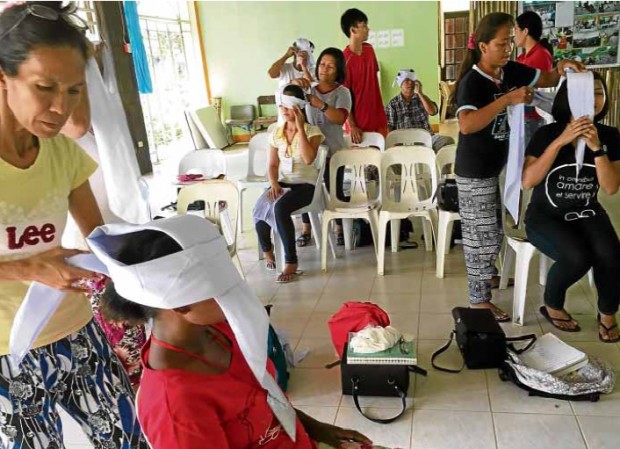
MEMBERS of different indigenous communities learn how to be “barefoot doctors” in a resettlement site in Subic. ALLAN MACATUNO
SUBIC, Zambales—In one corner of a chapel in an uphill community here, Belen Gumabon, 45, carefully binds the “wound” on the head of her patient with a clean dressing to control the bleeding.
Working beside her is Nelita Cristobal, 60, who straps an improvised sling made of a head scarf around the “injured” arm of another patient.
Both Gumabon and Cristobal share a mission to save lives in the remotest villages in the country.
They belong to two indigenous communities in Aurora province who were sent to the Aeta Resettlement and Rehabilitation Center here for a two-week training to become “barefoot doctors.”
On Feb. 5, 27 of them, representing eight mountain tribes across the country, became the center’s newest barefoot doctors.
One of the Department of Health’s “doctors to the barrio,” Dr. Dalvie Casilang, gathered them on Feb. 2 for a workshop on first aid at Sitio Gala in Barangay Aningway-Sacatihan here.
Education and training
The workshop is among the series of short courses offered under the 8th Indigenous Peoples Community Health Workers Training program that aims to educate IP communities on primary health practices and reduce ailments and deaths.
This year’s training, which began on Jan. 23, was organized by the Foundation of Our Lady of Peace Mission Inc. (FOLPMI).
The foundation started training IP members to become community health workers in 1975. As of 2008, it had produced 246 barefoot doctors from 118 tribes in the country.
One of them, Amelia Apang, 59, an Aeta from Pampanga, said she was looking forward to returning to her village to share the knowledge she acquired from the training.
“I would be able to help in educating people in our community about treating common health problems,” she said.
Dr. Jason Abello, health coordinator at FOLPMI’s Our Lady of Peace Hospital in Parañaque City, said most of the participating IP villagers this year were recommended by the tribal leaders of the Talaandig of Bukidnon, the Aeta of Zambales and Pampanga, the Itneg of Ilocos Sur, the Dumagat of Bulacan, the Hanunoo of Mindoro and the Agta-Dumagat of Aurora.
Frontline health workers
“We have some farmers and housewives who don’t have experience in public health service. But a few of them have basic health care knowledge,” Abello said.
He said the foundation is looking for people who could serve as “frontline health workers” when they return to their communities.
Their task includes services to prevent or treat serious health conditions such as tuberculosis, pulmonary disease, dengue and malaria, he said.
“This training gives hope to our community that is in dire need of community health workers,” said Gumabon, a member of the Agta-Dumagat community in Casiguran.
Many people in her community have died from serious illnesses without seeing a doctor, she said.
“In our community, if you don’t have the money to pay for a medical checkup, you’ll end up dying,” she said.
RM awardee
Developing barefoot doctors was the brainchild of FOLPMI founder and president, Sr. Eva Fidela Maamo, a surgeon-nun and a recipient of a Ramon Magsaysay Award in 1997 for her pioneering work in Lake Sebu in South Cotabato.
Maamo said the barefoot doctors would return to their communities to provide basic health services.
While conducting medical missions in remote villages in the 1970s, Maamo saw the need to educate the indigenous people in primary health care due to the increasing number of health-related deaths among them.
“Most of these tribal communities don’t have medical clinics and are seldom visited by health workers. Sadly, people there are dying without ever seeing a doctor,” she said.
She said she sought the help of volunteer doctors and nurses to train some IPs to become health workers for their own communities. The first batch of barefoot doctors was trained in 1975.
“A year after their training, they were able to reduce the incidence of disease to about one-third,” Maamo said.

